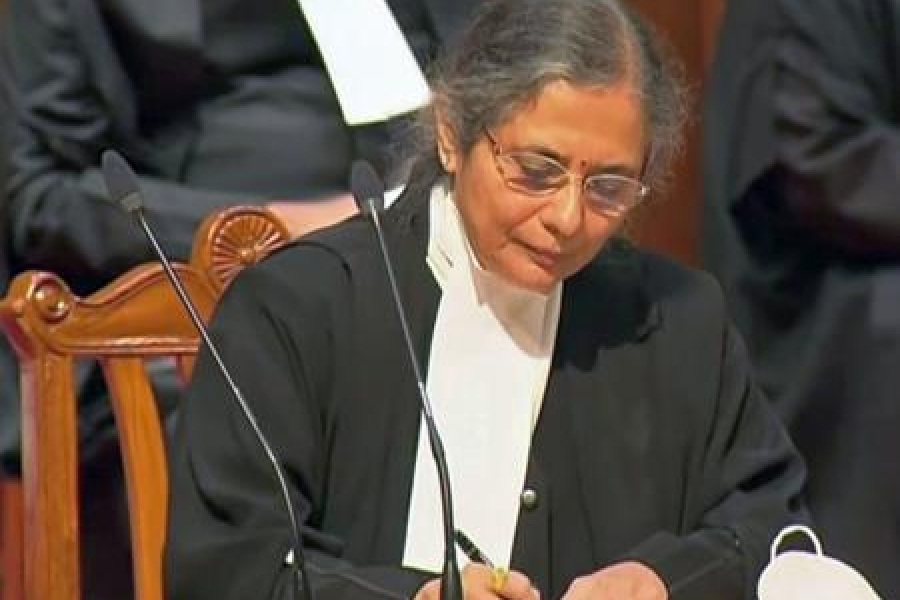 |
Bhubaneswar, Feb. 20: Salman Khan’s luck ran out when the local Bishnois in a Rajasthani village lodged police complaints against his hunting spree of black bucks in 1998. But did you know there are places in Orissa as well where local village communities have been protecting the animal?
With the help of the local forest officials, village communities in two regions — Bhetanoi-Balipadara in Ganjam district and Balukhand-Konark Wildlife Sanctuary in Puri district — have become immensely successful in conserving the animal. The number of black bucks in these two areas would be over 2,000 and 100 respectively. The-long term community efforts, coupled with religious beliefs, has led to an increase in the number.
The Indian black buck (antilope cervicapra) is one of the three species of antelopes found in Orissa. The other two are nilgai (Boselaphus tragocamelus) and the chowsingha (Tetracercus quadricornis).
The black buck is considered to be the fastest animal in the world after cheetah. Due to its restricted distribution and various threats, the black buck is included in the list of Schedule-I species of Wildlife (Protection) Act, 1972, and is designated as “vulnerable” according to the Red Data Book (1994).
A total of 15,000 black bucks are found in 13 states of India. Rajasthan has the highest number, which is around 8,000. A small population of the animal is also being protected with local support in Madhya Pradesh. While the population of this antelope is declining fast due to poaching and habitat loss, their number in Orissa is actually increasing.
In Puri’s Balukhand-Konark Wildlife Sanctuary, the black bucks are protected by the state government’s forest department under the concept of Protected Area Network.
In Bhetanoi-Balipadar-Buguda region of Ganjam district, local communities of 20 villages have joined hands to protect and conserve the animal through community conservation initiatives with help from the forest department.
Bhetanoi-Balipadar
The black bucks of Balipadar-Bhetanoi areas have been protected by the local people for several generations. Legend has it that more than a century ago, there was a long spell of drought in the area. During this period, a small group of black bucks appeared there and then there was rain. Since then, people had started protecting these animals because they feel that their fate is linked with them. In 1918, a Britisher known as Green Saheb and the “sardar” of the locality, Madeshi Chandramani Dora, took initiatives for the protection of this species and published a notification in the Oriya newspaper Prajamitra prohibiting the killing of black bucks.
The forest department had conducted a census of black bucks on May 14, 1973, in the Balipadar-Bhetanoi area. Subsequently, the census was conducted in 1980, 1998 and 2004 in the same area. Results of the 2004 census indicate that there has been a 42 per cent increase in the black buck population since the last count in 1998.
Out of three forest ranges of Buguda, Aska and Khallikote, Buguda range alone houses around 56 per cent of the black buck population.
To protect and conserve the black bucks, villagers from seven villages came forward and made a panel named Black Buck Management Committee in 2002. At that time, the population of black bucks was only 486. From 2002 to 2011, the committee has enrolled more members for better protection and management of the species. Now, the committee has expanded its membership from seven to 20 and the villages have been increased from seven to 26. This unique effort of conservation of the species has resulted in augmenting the number of black bucks from 486 in 2002 to 1,672, says the 2008 census. The committee consists of two forest range officers (Buguda and Aska), members from nearby 20 villages and the divisional forest officer (DFO) of south Ghumsura.
The black buck habitat covers about 60 per cent cultivated or cropped fields, 15 per cent rocky elevations, 10 per cent man-made houses and roads, eight per cent forest cover, five per cent water bodies and two per cent horticulture farms and waste lands. Another remarkable effort and sacrifice made by the local villagers is that they have donated their land to dig ponds in the two favourite habitats of the black bucks to compensate for the water scarcity during summer.
According to DFO Ramesh Chandra Sethi, two villagers named Sashibhusan Upadhaya and Harshchand Dora have donated 50 decimal land of each in two places to dig ponds for the blackbucks. The committee has shown its interest to carryout a systematic survey on black bucks, their ecology before declaring the area as a community reserve.
“It is also known that some of the black bucks were nurtured by the villagers, after which they were left free in the cultivated fields. Some people even put bells on the neck of some of these black bucks, an act showing intimacy in the relationship. The black bucks recognised this intimate relationship by taking the presence of the protecting villagers easily. They are not frightened to see these villagers unless there is some outsider (recognised by his costume and activities which the black bucks are not familiar with). Some of them even enter the villages occasionally,” said committee member Krushna Chandra Gauda.
“Bucks use cultivated land as their habitat and prefer to remain closer to the protecting villages. Instead of entering the bordering forest areas to continue their life in the wild, the bucks share the common grazing grounds with the cattle. The success of this community protection is evident from the statistics of black buck census. In 1918, their number was around 100 (estimates the protecting villagers), the census done in 1998 revealed their number to be 551 and finally the census of 2008 pegged the number at 1,672,” said former local sarapanch Amulya Upadhya, who was responsible for the building up movement to protect black bucks in the area.
“More than 1,000 tourists a year come to our region from far away places like Delhi, Dhaka, Calcutta and Hyderabad but there is no guest house here. The only one available is far away, so the construction of a guest house in the Betanoi area would also add to the tourism development process. There is another tourist destination called Kankana Devi, which is near Betanoi and tourists coming to see black bucks also visit the place,” said Upadhya.
Balukhand-Konark
Balukhand-Konark Wildlife Sanctuary in Puri district is a 71.7 square kilometre area established on a sandy tract along the coast between Puri and Konark. According to the villagers, as the plantation cover became dense and luxuriant, the black bucks and spotted deer population were sighted in the area which increased in the due course of time.
Some people believed as the cover of the forest increased, it provided a shelter to the animals and they migrated from the adjoining Mal reserve forest. However, there is no authentic evidence as to from where these animals have migrated from.
However, residents of 45 villages along the Balukhand-Konark sanctuary stretch have been actively protecting the forests and wildlife of the sanctuary, especially the spotted deer and black bucks.
Villagers have helped to check poaching activities and this led to the improvement of the habitat and wildlife of the sanctuary, where the main animals found are the spotted deer and the black buck.
Puri DFO Sarat Mishra acknowledged that due to the active help of villagers, the number of black bucks and spotted deer has increased. According to him, in the last census held in 2005, the number of black bucks was around 110 and the number of spotted deer was more than 2,000.
“The census report of 2010 will cross the 110 mark and it is a healthy trend,” a forest official said.










